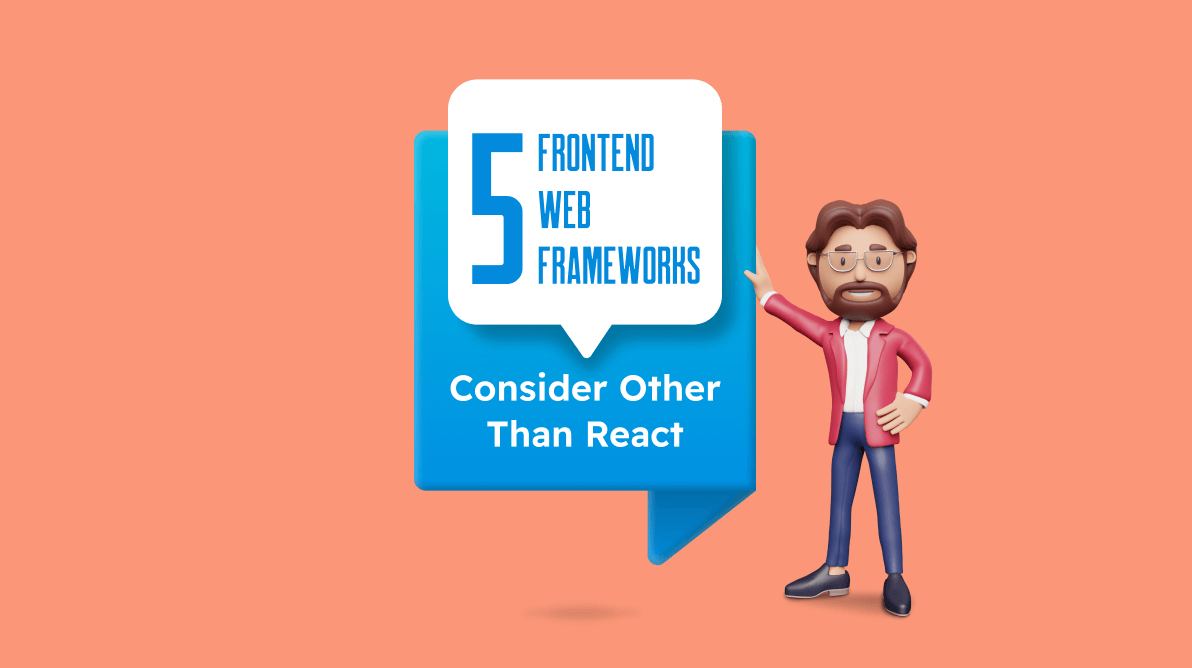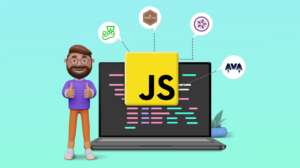Modern web development requires developers to focus on creating complex logic, improving performance, and serving users on different networks across the globe rather than focusing on the project setup and working on the boilerplate.
The inception of front-end frameworks has helped developers in formerly unimaginable ways. These frameworks provide a suite with all the functionalities and performance-tuning options one needs to create a stunning web app. For example, you can create a simple client-side rendered app, a server-side rendered app, or a hybrid application. Use them to create desktop, mobile, or web applications—the possibilities are endless.
Front-end frameworks provide so many options to get started with a single command, comprising all the front-end stuff like HTML, CSS, JavaScript, and static files. Importantly, they are flexible enough to integrate and support different libraries to scale and support large applications.
Since its introduction, React has been one of the most preferable and popular front-end frameworks. It uses JSX (JavaScript with XML), which allows you to write JavaScript as HTML, with the help of the Babel compiler and a virtual DOM with declarative APIs to yield better performance. Its popularity and community adoption have led to its growth beyond the web. Its native-focused offshoot, React Native, can also be used for mobile app development.
React is just one of many choices for the front-end. Each framework tries to overcome some of the drawbacks of the others.
This blog will discuss front-end frameworks other than React that are popular and a good fit for web application development.

Syncfusion JavaScript UI controls are the developers’ choice to build user-friendly web applications. You deserve them too.
1. Angular
Angular, an open-source, TypeScript-based front-end development framework, was developed by Google. It is an efficient framework that can be used to create single-page web applications with client-side or server-side rendering. It promotes component-based app development and includes a rich feature set like directives, filters, two-way data binding, and dependencies, making it a suitable choice for creating scalable web applications.
Angular’s set of tools allow creating, building, testing, and shipping web apps faster. Backed by great community support and an amazing collection of libraries, it is an ideal choice to create everything from simple to enterprise-grade web applications.
Pros
- Synchronization: Two-way data binding ensures the changes between the view and the model are synchronized in real-time.
- Secure: Uses Typescript to reduce errors at the compiler level, ensuring better security.
- Adaptable: You can use Angular to create a client-side or server-side rendered web applications, and even to create mobile applications.
Cons
- Learning curve: Many developers state that Angular is not beginner-friendly and has a steeper learning curve than React or Vue.
- Large size: Being heavier than React, Angular may require code optimization for dynamic apps.
2. Vue
Fairly new and written completely in TypeScript, Vue is a small yet powerful front-end framework. It follows MVVM architecture and supports all the native features of HTML, CSS, and JavaScript. There is no JSX or any wrapper around the framework. Like React, it also follows component-based development, but unlike React, it encapsulates the logic in a template. That is, the complete HTML, CSS, and JavaScript code resides in a single file. Being reactive in nature, Vue automatically detects the state update in the JavaScript code, which is reflected in the DOM with the help of the virtual DOM.
Pros
- Progressive: Vue is designed to adapt and create web apps based on the developer’s requirements. You can create apps rendered on the client side or server side; Jamstack apps; apps for mobile, web, or desktop; or even use Vue on a terminal
- Virtual DOM: Vue uses a virtual DOM to differentiate the HTML nodes to update, drastically improving performance.
- Single-file component: Vue abstracts the component logic in a template or single file where all the HTML, CSS, and JavaScript code.
Cons
- Less community support: Being fairly new, it has not yet been widely adopted, and thus you will find fewer libraries and packages built for Vue.
- Not scalable: It cannot be used to create large-scale enterprise applications.

Every property of the Syncfusion JavaScript controls is completely documented to make it easy to get started.
3. Svelte
Svelte is one of the youngest in the front-end framework league. Unlike other front-end frameworks , Svelte does not use a virtual DOM. Instead, it uses a specialized JavaScript compiler designed specifically for creating user interfaces, making it highly efficient and up to 10 times faster than frameworks that use virtual DOMs like React, Vue, and Angular.
The secret to Svelte’s performance is that the majority of its work is done at the compilation level rather than at the execution level in the browser. Still, Svelte uses component-based development just like its peers.
Pros
- Less code: In Svelte, the same functionality of other frameworks can be achieved in less code thanks to imperative code that surgically updates the DOM.
- No virtual DOM: Svelte does not use a virtual DOM, instead choosing a different approach to update the original DOM in an efficient way that is still reactive and increases
- Tiny and fast: It is a very tiny framework but ultra-fast compared to its peers.
Cons
- Less adoption: Being one of the youngest frameworks, it is still not widely adopted by the community.
- Few third-party libraries: Since it is not widely adopted by the community yet, you will find fewer libraries and packages built around Svelte.
4. Preact
Preact is a 3.5 KB alternative to React that uses the same cutting-edge API. Because it is designed to run in the browser with a minimalist virtual DOM abstraction on top of the actual DOM, it is tiny in size. It does not require any transpilation and uses real event handlers. Being natively compatible with browsers, it beats other JavaScript frameworks in terms of speed.
Preact is quite well-liked, as seen by the 34,400 GitHub stars and 2.4 million weekly downloads it has at the time this article was being written.
Preact is the best choice if performance, speed, and application size are crucial to you. It is primarily used to make complex web applications.
In addition, Preact is built on top of React, so there is little new information to learn. Due to its compatibility and resemblance to React, it is easy to use and can be combined with the current React package by using the preact/compat package.
Pros
- Closer to the browser: With Preact, you can use the actual event listeners rather than the synthetic events in React, even though Preact uses a virtual DOM.
- Native support for ECMAScript modules: Preact can be imported natively in the browser using ECMAScript modules without a bundler.
- Tiny and fast: Preact is the best framework for creating high-performance lightweight apps because it is only 3.5 KB and renders quickly using an optimized diff algorithm.
- Integrable: With the use of preact/compact package it becomes thoroughly compatible with the React APIs, making it a great fit if you’re looking to inject some high-performance synergy into your React project.
Cons
- Dependent: Since it is similar to React, if you want to use a React API, you will have to import additional packages to make it work.

To make it easy for developers to include Syncfusion JavaScript controls in their projects, we have shared some working ones.
5. jQuery
Last but not least, jQuery, the oldest of the bunch, is still very popular and is widely used in many different websites thanks to early adoption and the flexibility it provided before the emergence of more modern frameworks. It is still a great choice if you are looking for a fast front-end library for DOM manipulation, CSS updates, event listening, and performing network calls that comes with it easy to use api’s.
WordPress, which powers 43% of websites, still uses jQuery and many of its themes too.
Pros
- Simplicity: Extremely simple APIs to use, easy to learn and adapt.
- Cross-browser support: jQuery is time-tested and thus supports most older browsers.
- Huge community: Due to its popularity and early adoption, jQuery has tremendous community support. Finding solutions for almost any issue with jQuery is very easy.
Cons
- Outdated: It cannot be used beyond doing the usual DOM and CSS manipulation

Easily build real-time apps with Syncfusion’s high-performance, lightweight, modular, and responsive JavaScript UI components.
Conclusion
In this article, I discussed the top five front-end web frameworks besides React for developing web applications. As developers, we should always know the alternatives and best fit for the applications we develop.
These suggestions will help you pick the right web framework for your future or even current projects. Thank you for reading.
The Syncfusion JavaScript suite is the only suite you will ever need to build a web application. It contains over 80 high-performance, lightweight, modular, and responsive UI components in a single package. Download the free trial and evaluate the controls today.
If you have any questions or comments, you can contact us through our support forums, support portal, or feedback portal. We are always happy to assist you!




